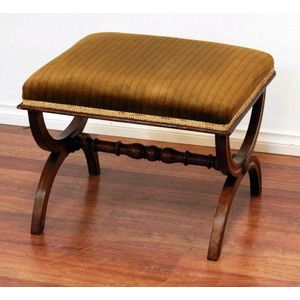Regency Walnut Foot Stool with Reeded End Supports
A late Regency walnut foot stool, with padded seat above x reeded end supports with turned stretcher
You must be a subscriber, and be logged in to view price and dealer details.
Subscribe Now to view actual auction price for this item
When you subscribe, you have the option of setting the currency in which to display prices to $Au, $US, $NZ or Stg.
This item has been sold, and the description, image and price are for reference purposes only.
- Regency Period - The Regency period in English furniture design refers to the period when King George III, was declared unfit to rule in 1811, and his son ruled as proxy as Prince Regent, until 1820, and then, after the death of his father as George IV until his death in 1830. The Regency period was preceded by the Georgian period (George I, George II, and George III: 1714 - 1811), and was followed by the William IV period, which only lasted until 1837 when William IV died as was succeeded by Queen Victoria.
- Reeding - A series of parallel, raised convex mouldings or bands, in section resembling a series of the letter 'm'. The opposite form of fluting, with which it is sometimes combined. Reeding is commonly found on chair legs, either turned or straight, on the arms and backs of chairs and couches and around table edges in the Neoclassical or Classical Revival manner. Reeding was also used as a form of decoration during the Edwardian period, but it is usually much shallower and evidently machine made.
- Turning - Any part of a piece of furniture that has been turned and shaped with chisels on a lathe. Turned sections include legs, columns, feet, finials, pedestals, stretchers, spindles etc. There have been many varieties and fashions over the centuries: baluster, melon, barley-sugar, bobbin, cotton-reel, rope-twist, and so on. Split turning implies a turned section that has been cut in half lengthwise and applied to a cabinet front as a false decorative support.
- Stretcher - A horizontal rail which connects the legs of stools, chairs, tables and stands, to provide stabilisation of the legs. A stretcher table is any table with a stretcher base. The term is usually applied to substantial farmhouse tables, although many cabinetmaker's pieces, such as sofa tables, also have turned stretchers.
This item has been included into following indexes:
- stools, period or age - Regency 16
-
stools, type or function
- foot stools 180
- upholstered 338
- X frame 10
Visually similar items

An Edwardian mahogany octagonal side table on fluted legs carved fretwork to sides 74 x 77 x 75 cm
Sold by
in
for
You can display prices in $Au, $US, $NZ or Stg.

An 1840's mahogany extension table having three leaves, adjustable crank mechanism, reeded legs on original casters, 74 x 300 x 138 cm
Sold by
in
for
You can display prices in $Au, $US, $NZ or Stg.

Fine Victorian burr walnut sewing table with lift top and fitted compartment interior,
Sold by
in
for
You can display prices in $Au, $US, $NZ or Stg.

A Regency mahogany two drawer sofa table. 74 cm high, 160 cm wide, 58 cm deep.
Sold by
in
for
You can display prices in $Au, $US, $NZ or Stg.
